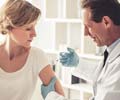Globally $35 billion will be required for immunization in the next ten years to save an additional ten million lives.

But there is a huge financial gap of $10-15 billion, which the Global Alliance on Vaccines and Immunization (GAVI) hopes rich countries will bridge.
However, there was a shortfall of $10 ten to $15 billion dollars in ensuring rapid development and availability of vaccines worldwide, which is crucial in reducing childhood mortality. This amount would have to be met by increasing the contributions from the governments, international organisations and from other sources like solidarity tax and levy on air tickets, Mr Lob-Levyt, secretary of GAVI said. Norway has already announced that it will give $75 million annually to the fund for the next decade.
The current $2.5 billion annual spending on immunization in the poorest countries would have to be increased to $3.5 billion by 2010 and $4 billion by 2015 to achieve the goal.
"For the first time we have a costed global picture, a global strategy and a process for tracking needs against the available resources. This information was a great achievement by WHO, UNICEF and other partners. It places GAVI Alliance in a great position to respond to the challenges posed by the partners' Global Immunization Vision and Strategies program," Mr Lob-Levyt said.
Of the $35 billion needed for the 72 poorest countries in the next decade, there is a $10-15 billion funding shortfall if we are to achieve the goal of saving 10 million more lives. This huge shortfall of $10-15 billion is needed for immunization to save millions of lives in the next 10 years, the GAVI urged rich nations to contribute generously. Another 10 million lives could be saved if an additional $ 1 billion is spent on child and maternal immunization between 2006-2015, experts said.
Many of the vaccines against these diseases have been in use in the developed countries for the last 15 years, but have failed to reach the poor nations mainly due to their high cost.
Of the estimated $35 billion, 15 percent would be needed to buy the vaccines available and those being developed, and the rest to strengthen the system to take the vaccine to the children, Director of Immunisation at the World Health Organization, Jean-Marie Okwo-Bele told reporters.
The total amount spent by GAVI on vaccines will rise from about $350 million a year in 2005 to $1.5 billion by 2015 as the coverage is expanded with vaccines currently used and new vaccines.
"Our target is to make the vaccines in the rich nations available to the poor nations and reach out to 15 million additional children over the next ten years," Lob-Levyt said.
The introduction of new vaccines in the national immunisation programs of poor nations has seen the expenditure rise from $2.5 per child from $5, he said. In the last five years, GAVI has supported immunisation of 100 million additional children with new generation vaccines.
A key component of GAVI's expansion drive over the next decade is to involve the pharmaceutical sector in the developing countries like India in research and development of some new vaccines like rotavirus, malaria, HIV and Japanese encephalitis.
Accounting for about 60 percent of the vaccines used by UNICEF for the immunisation programs, India is expected to continue playing an active role in future programs.
Several Indian companies, including the Serum Institute, Shanta Biotech, Panacea Biotech and Bharat Biotech, have already been pre-qualified by the WHO for export of vaccines.
Many of these companies are partners in developing new vaccines. This trend of having more than one manufacturer in the fray will bring down the cost of vaccine production, making efforts of GAVI widely reachable, the experts said.







